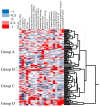Identification of Markers Predicting Clinical Course in Patients with IgG4-Related Ophthalmic Disease by Unbiased Clustering Analysis
- PMID: 33348892
- PMCID: PMC7766793
- DOI: 10.3390/jcm9124084
Identification of Markers Predicting Clinical Course in Patients with IgG4-Related Ophthalmic Disease by Unbiased Clustering Analysis
Abstract
Purpose: To describe the clinical features of patients with immunoglobulin G4 (IgG4)-related ophthalmic disease (IgG4-ROD) grouped by unbiased cluster analysis using peripheral blood test data and to find novel biomarkers for predicting clinical features.
Methods: One hundred and seven patients diagnosed with IgG4-ROD were divided into four groups by unsupervised hierarchical cluster analysis using peripheral blood test data. The clinical features of the four groups were compared and novel markers for prediction of clinical course were explored.
Results: Unbiased cluster analysis divided patients into four groups. Group B had a significantly higher frequency of extraocular muscle enlargement (p < 0.001). The frequency of patients with decreased best corrected visual acuity (BCVA) was significantly higher in group D (p = 0.002). Receiver operating characteristic (ROC) curves for the prediction of extraocular muscle enlargement and worsened BCVA using a panel consisting of important blood test data identified by machine learning yielded areas under the curve of 0.78 and 0.86, respectively. Clinical features were compared between patients divided into two groups by the cutoff serum IgE or IgG4 level obtained from ROC curves. Patients with serum IgE above 425 IU/mL had a higher frequency of extraocular muscle enlargement (25% versus 6%, p = 0.004). Patients with serum IgG4 above 712 mg/dL had a higher frequency of decreased BCVA (37% versus 5%, p ≤ 0.001).
Conclusion: Unsupervised hierarchical clustering analysis using routine blood test data differentiates four distinct clinical phenotypes of IgG4-ROD, which suggest differences in pathophysiologic mechanisms. High serum IgG4 is a potential predictor of worsened BCVA, and high serum IgE is a potential predictor of extraocular muscle enlargement in IgG4-ROD patients.
Keywords: IgG4-related ophthalmic disease; biomarker; decreased best corrected visual acuity; extraocular muscle enlargement; unbiased cluster analysis.
Conflict of interest statement
No conflicting relationship exists for any author.
Figures




Similar articles
-
Pathological count of IgG4-positive plasmacytes suggests extraophthalmic involvement and relapse in patients with IgG4-related ophthalmic disease: a retrospective study.Arthritis Res Ther. 2022 Apr 1;24(1):80. doi: 10.1186/s13075-022-02757-2. Arthritis Res Ther. 2022. PMID: 35365184 Free PMC article.
-
Cases with IgG4-related ophthalmic disease with mass lesions surrounding the optic nerve.Am J Ophthalmol Case Rep. 2022 Jan 25;25:101324. doi: 10.1016/j.ajoc.2022.101324. eCollection 2022 Mar. Am J Ophthalmol Case Rep. 2022. PMID: 35146198 Free PMC article.
-
IgG4-related ophthalmic disease involving extraocular muscles: case series.BMC Ophthalmol. 2018 Jul 3;18(1):162. doi: 10.1186/s12886-018-0819-x. BMC Ophthalmol. 2018. PMID: 29970061 Free PMC article.
-
IgG4-related disease: a neuro-ophthalmological perspective.J Neuroophthalmol. 2014 Dec;34(4):400-7. doi: 10.1097/WNO.0000000000000193. J Neuroophthalmol. 2014. PMID: 25405662 Review.
-
IgG4-Related Ophthalmic Disease. Part II: Clinical Aspects.Ophthalmic Plast Reconstr Surg. 2015 May-Jun;31(3):167-78. doi: 10.1097/IOP.0000000000000364. Ophthalmic Plast Reconstr Surg. 2015. PMID: 25564258 Review.
Cited by
-
Identification of markers predicting clinical course in patients with Behcet disease by combination of machine learning and unbiased clustering analysis.Graefes Arch Clin Exp Ophthalmol. 2025 May 6. doi: 10.1007/s00417-025-06850-5. Online ahead of print. Graefes Arch Clin Exp Ophthalmol. 2025. PMID: 40325212
-
Applications of artificial intelligence and bioinformatics methodologies in the analysis of ocular biofluid markers: a scoping review.Graefes Arch Clin Exp Ophthalmol. 2024 Apr;262(4):1041-1091. doi: 10.1007/s00417-023-06100-6. Epub 2023 Jul 8. Graefes Arch Clin Exp Ophthalmol. 2024. PMID: 37421481
References
-
- Stone J.H., Khosroshahi A., Deshpande V., Chan J.K., Heathcote J.G., Aalberse R., Azumi A., Bloch D.B., Brugge W.R., Carruthers M.N. Recommendations for the nomenclature of IgG4-related disease and its individual organ system manifestations. Arthritis Rheum. 2012;64:3061–3067. doi: 10.1002/art.34593. - DOI - PMC - PubMed
-
- Wallace Z.S., Zhang Y., Perugino C.A., Naden R., Choi H.K., Stone J.H., ACR/EULAR IgG4-RD Classification Criteria Committee Clinical phenotypes of IgG4-related disease: an analysis of two international cross-sectional cohorts. Ann. Rheum. Dis. 2019;78:406–412. doi: 10.1136/annrheumdis-2018-214603. - DOI - PMC - PubMed
LinkOut - more resources
Full Text Sources

